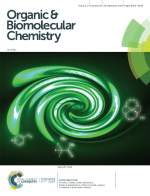
Electron transfer controlled by solvent and counter-anion dynamics in electrochemistry of viologen-type ionic liquid
The paper authored by N. Bodappa, Y.-Ch. Fu, P. Broekmann, J. Furrer, K. Zick,
S. Vesztergom,
H. Tahara and T. Sagara
is published in Electrochimica Acta (2019, vol. 320, pp. 134559).
Abstract:
Temperature-dependent diffusion coefficients (DO) and heterogeneous electron transfer rate constants (k0) were measured for the viologen dication (V2+) in 1-butyl-1′-heptyl-4,4′-bipyridinium bis[(trifluoromethane)sulfonyl]imide [C4VC7][Tf2N]2 redox-active ionic liquid (RAIL) and its solution. The measurements were made in three systems: (1) 10 mM of [C4VC7][Tf2N]2 dissolved in 0.1 M K[Tf2N]/acetonitrile (an organic electrolyte), (2) 10 mM [C4VC7][Tf2N]2 dissolved in a 1-n-hexyl-3-methylimidazolium tris(pentafluoroethyl)-trifluorophosphate, [HMIm][FEP] ionic liquid (IL) (an ionic liquid (IL) electrolyte), and (3) the undiluted RAIL of 1.68 M [C4VC7][Tf2N]2 with no additional solvents or supporting electrolytes. At 25 °C, the DO values in systems (1), (2), and (3) were 8.2 × 10−6, 6.7 × 10−8, and 1.3 × 10−9 cm2 s−1, and the k0 values were 1.1 × 10−2, 3.6 × 10−3, and 2.0 × 10−5 cm s−1, respectively. Temperature-dependent DO and k0 values were further interrelated to investigate heterogeneous interfacial electron transfer processes in systems (2) and (3). Solvent dynamics and counter-ion relaxation processes were used to describe the results. In system (3), k0 values were proportional to both DO and counter-ion diffusion coefficients (DCIon) but inversely proportional to the viscosity (η). Moreover, almost the same magnitude of thermal activation barrier (∼64 kJ mol−1) was found for k0, DO, DCIon, and η−1 in the system (3). In system (2), k0 values showed a non-linear relationship with DO, DCIon and η−1, and a thermal activation barrier was found to be 22.2 kJ mol−1. These results enabled us to conclude that the V+/V2+ heterogeneous electron transfer in system (3) is controlled concurrently by solvent dynamics (segmental motion of alkyl chains attached to viologen centers) and electro-inactive counter anion motion. This work reveals an inherent dependency of heterogeneous electron transfer kinetics on the solvent and counter-ion dynamics in viologen IL systems.
